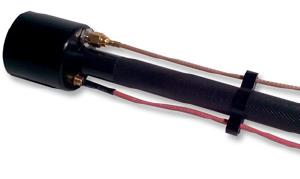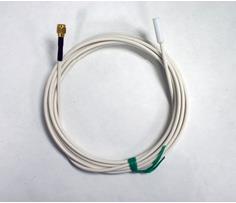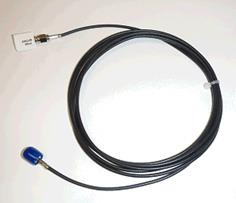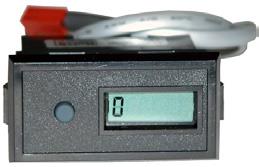The Novx MiniPulse ESD Event Detector is designed for tool and process monitoring. This affordable, small footprint embeddable monitor has been developed to warn of product damage risks at the point of electrostatic discharge. The MiniPulse uses time domain and threshold discrimination to detect pulse electromagnetic energy. Through the use of specific antenna configurations and placement, the MiniPulse can provide ESD event detection for specific small areas.
Features
- Small Footprint
- Red/Green LED Alarm; Audible alarm
- Open Collector Output on Alarm
- 9-24 VDC power input, including 9V battery operation
- Variable antenna orientations and adjustable threshold settings
- Can easily fit inside a tool or in a manufacturing line
- Visual and audible alarms of ESD events
- Can integrate into a Factory Monitoring System
- Multiple power options provide flexibility in use
- Can tune the unit to specific applications while eliminating false alarms
Specifications:
| Novx MiniPulse ESD Event Monitor | |
| Power | 9-24 VDC --- , 30 mA (9V alkaline battery option can be used to provide up to 20 hours of operation, no ground required) |
| Power Input Connector | 0.100” header, locking, 2-pin 0.025” square right angle posts (mating connector is a Molex 22-01-3027, TE Connectivity 3-640440- 2 or other equivalent connector) |
| LED Indicators | Green NORMAL OPERATION; red ESD event |
| Audible Alarm | Piezo buzzer sounds momentarily on ESD event |
| Alarm Output | Open collector pulls to GND on alarm + 24 VDC max; 0.2A load max |
| Alarm Output Connector | 0.100” header, locking, 2-pin 0.025” square right angle posts (mating connector is a Molex 22-01-3027, TE Connectivity 3-640440-2, or other equivalent connector) |
| Antenna Connector | SMA |
| User Adjustments | Detection level adjustment via "Level" trimpot; pulse detection length |
| Response | 50 ms (reset time) |
| Range | 1-1000 V/m radiated ESD event |
| Accuracy | ±20 V/m radiated amplitude |
| Operating Env. | Temperature +40ºF to +120ºF (5-49ºC) electronics; + |
| Storage Temp | +40ºF to +120ºF (5ºC to 49ºC) with unit in original packaging |
| Cleaning | The exterior of the MiniPulse stainless steel chassis may be cleaned with a dry cleanroom cloth or a cleanroom cloth dampened with distilled or deionized water |
| Dimensions | 4 oz (113g) |
| Certifications |  |
| CDMES | |
| Power | Variable benchtop DC power 2 kV supply |
| Power Input Connector | 0.100” header, locking, 2-pin .025” square right angle posts (mating connector is a Molex 22-01-3027, TE Connectivity 3-640440-2 or other equivalent connector) |
| Oscilloscope Connector | SMA-male (RG-316 cable) |
| User Adjustments | Voltage input level controlled through DC power supply level |
| Response | 50 ms |
| Range | 25-2000 VDC (using 14-1245 power supply) |
| Accuracy | ±10V/m radiated amplitude |
| Operating Env. | Temperature +40ºF to +120ºF (5-49ºC); humidity 10-60% RH, non-condensing |
| Storage Temp | +40ºF to +120ºF (5-49ºC) with unit in original packaging |
| Cleaning | Periodic point replacement only |
| Dimensions | 7.67L x 1.65W inches |
| Weight | 3.6 oz (102g) |
| Certifications |  |
Ordering Information
| 9904-0002-0000 | MiniPulse ESD Event Monitor |
| 14-1245 | Universal Power Supply, 12 VDC@1.25A (optional) |
| 33-3050 | 9V (adapter) battery included (optional) |
| 33-0527-xx | Micro ESD Antenna with cable (xx=cable length available in 6 ft or 12ft) |
| 33-0529-8 | MPA-01 Micro Directional ESD Antenna with 8 ft Remote Coax cable |
| 33-0530-8 | MPA-02 Micro Directional ESD Antenna with 8 ft Remote Coax cable |
| 33-4400-5 | LCD Event counter module with 5 ft cable |
| 92-0003-01 | Charge Device Model Event Simulator (incl. cable and 2 attenuators) |
| 92-0003-02 | Charge Device Model Event Simulator (incl. power supply, cables and 2 attenuators) |
Main Features
Controlling ESD detection by pulse length. The MiniPulse is able to discriminate between different pulse event types. This allows it to determine valid ESD-type events from other pulse packet signals (cell phone, WiFi, etc.).
Threshold Control. Due to electromagnetic field attenuation over distance, many wider-area ESD events can be filtered out by adjusting the threshold to match local event amplitudes. The MiniPulse threshold control sensitivity allows fine tuning down to very small acquisition areas. This is an important aspect of limiting detected ESD events to only those of critical importance.
Antenna Configuration. Another key factor in limiting ESD event detection to a specific process point is the form and placement of the antenna. The physical gain characteristics of the antenna play a part in controlling signal acquisition.
Noise Insensitivity. Differing antenna lengths and types can be calibrated to reject unwanted signal noise based upon antenna surface (the amount of antenna presented to the incident field), orientation and frequency wavelength. One of the major challenges to embedded ESD detectors is accommodating robotic noise signatures and other tool/environmental noise without triggering false ESD alarms. The MiniPulse has been specifically designed for this type of application.
Special Features
The Minipulse can be used with a 9V battery attachment for portability. This useful feature lends itself to ESD investigations in enclosed tools where power cable routing is problematic. The available standard Micro ESD antenna is designed for close proximity ESD event detection. This antenna is rated for use in high temperature environment locations up to 390°F (200°C). The Micro Directional ESD Antenna is for use in electrically noisy environments, to reduce false positive signals.
Calibration
The MiniPulse is shipped preset for maximum sensitivity. The end user will need to perform a basic calibration procedure to adjust the Alarm sensitivity to a level that is appropriate for their environment. Calibration should be validated annually to meet ISO certification compliance requirements.

The optional Charge Device Model Event Simulator (CDMES) was designed to allow ESD detectors to be calibrated inside the tools and processes where CDM events occur. This simulation tool allows calibrated CDM events of different magnitudes to be produced at the location where production devices are most vulnerable and where ESD monitoring sensors are located. Other options:



Micro ESD Antenna Micro Directional ESD Antenna LCD Event Counter
